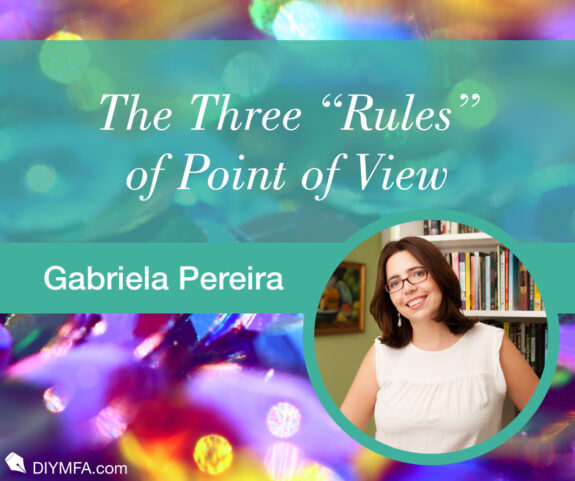Point of view is one of the trickiest and most technical aspects of writing, but it’s also my favorite. There are so many choices and possibilities—it’s like being in the literary version of a candy store! At the same time, however, this variety of options can be overwhelming, making us feel like we’re being pulled in a million different directions.
In the latter case, the best approach is to have some ground rules or guidelines. These will keep us focused amid the myriad of choices and help us select the best point of view for our story. Here are three point of view “rules” or guidelines to keep in mind.
1) Keep It Consistent
One of the most important things to remember about point of view is to keep things consistent. If you start out in first person (the “I” perspective) and then suddenly switch to third person (the “he/she/they” perspective) halfway through your novel, you’re going to throw your reader for a loop. You see, when you switch the point of view without any warning, the reader won’t know whose perspective the story is supposed to be in. This leads to confusion, and it might even lead the reader to put down the book altogether.
Part of keeping things consistent is also keeping a similar pattern to how the point of view plays out in your story. Imagine, for example, that you are writing a book with two alternating points of view. If you alternate between only characters A and B, adding a third perspective (character C) partway through the book will create similar confusion as described above.
In addition, you might have certain formats that you need to keep consistent. For instance, if you have multiple points of view, you might use the name of the character as the chapter heading, to clue your reader in a little bit. If your story has timeline jumps, you might also want to include dates in the chapter heading, or any other information that might be pertinent to the story. Consider the book Shiver by Maggie Steifvater, which alternates between the points of view of two teenagers: Grace and Sam. At the start of every chapter, we find the name of the point of view character, as well as the temperature. This is because temperature plays an important part in the paranormal aspect of the story.
The beautiful thing about point of view is that there is room to experiment. Usually, by the time you have completed draft zero (the first messy draft), you will have a good sense for what point of view you want to use. From there, the only thing you need to do is go back and rework the scenes where you might have experimented with a different point of view. Once you have figured out the point of view you want, you need to make sure all the scenes in your story are consistent with it.
2) Keep It Sustainable
It can be a lot of fun to try different point of view options, like: second person (the “you” perspective), diary or epistolary, interwoven story threads, you name it. The place where things get tricky is keeping the point of view choice sustainable, something you can keep up for the length of an entire book.
Using the second person is a great example. While many short stories use this point of view, very few novels do. The most famous, perhaps, is Bright Lights, Big City by Jay McInerney. This book is told entirely in the second person, and I can only imagine how challenging it must have been for the author to sustain. The second person perspective equates the reader with the protagonist, shoving the reader into that character’s shoes. This point of view talks directly to the reader as though they are the main character of the story. Consider the opening of Bright Lights, Big City:
You are not the kind of guy who would be at a place like this at this time of the morning. But here you are, and you cannot say that the terrain is entirely unfamiliar, although the details are fuzzy. You are at a nightclub talking to a girl with a shaved head. The club is either Heartbreak or the Lizard Lounge. All might come clear if you could just slip into the bathroom and do a little more Bolivian Marching Powder. Then again it might not.
Notice how, although we know the “you” character is not us, we feel as though we are being shoved into that character’s perspective. In the case of this story, it works, because the character is a bit unlikable, so this perspective helps the reader relate. The danger, of course, with a point of view like this is that it could feel gimmicky, as though the author is using that point of view to prove they can, and not necessarily because it is the best choice for the story.
Another place where it’s important to keep things sustainable is when thinking through the strategy of the point of view. Consider, for instance, the peripheral first person. This is the point of view where the narrator is a supporting character in the story, rather than the main character. An example of this point of view in action is The Great Gatsby by F. Scott Fitzgerald.
When you have a peripheral first person point of view, there will be certain pieces of information or episodes in the narrative that the point of view character will not be able to access. This means that you, the writer, must be strategic in what you show the reader. You may have to maneuver the plot to get that point of view character into a scene, or you may have to get creative in terms of conveying certain information to the reader if the narrator doesn’t have access to it.
Consider the following excerpt from The Great Gatsby with the exchange about the shirts. This scene is really about Gatsby and Daisy, and narrator Nick Carraway has no real reason to be in it. The only reason he is present is because he is the point of view character, and that means the only way to make the scene work is to include him as a quiet observer.
Recovering himself in a minute he opened for us two hulking patent cabinets which held his massed suits and dressing-gowns and ties, and his shirts, piled like bricks in stacks a dozen high.
“I’ve got a man in England who buys me clothes. He sends over a selection of things at the beginning of each season, spring and fall.”
He took out a pile of shirts and began throwing them, one by one before us, shirts of sheer linen and thick silk and fine flannel which lost their folds as they fell and covered the table in many-colored disarray. While we admired he brought more and the soft rich heap mounted higher—shirts with stripes and scrolls and plaids in coral and apple-green and lavender and faint orange with monograms of Indian blue. Suddenly with a strained sound, Daisy bent her head into the shirts and began to cry stormily.
“They’re such beautiful shirts,” she sobbed, her voice muffled in the thick folds. “It makes me sad because I’ve never seen such—such beautiful shirts before.”
This type of strategic thinking is not reserved solely for the peripheral first person. No matter what point of view option you choose, you will have to think strategically about what information you can convey to your reader while staying within the constraints of that perspective. If there is information your point of view character does not have access to, you may have to do some storytelling acrobatics to make it work.
3) Keep It Real
When we consider point of view, we need to remember why different points of view came into use in the first place. I once had a fabulous conversation with author David Morrell about this very subject. He shared that the reason different points of view came into use is because they created varying degrees of verisimilitude, i.e. the feeling that the story could be real.
Consider Robinson Crusoe by Daniel Defoe, a work which many consider the first English novel. This book is written in first person and that point of view choice creates the sense that we are getting a firsthand account from Crusoe himself. Pamela (or Virtue Rewarded) by Samuel Richardson creates a sense of verisimilitude in a different way. In this case, the story is told in epistolary form, so it feels almost as though we are snooping in the characters’ private correspondence. Later on, many novels by Charles Dickens and Jane Austen use an omniscient third person point of view, creating a sense of distance objectivity. The story feels true because we are getting “just the facts” from an objective source.
As you choose the point of view for your story, ask yourself: “How does this choice contribute to the authenticity of my story? How does it make my story feel real?”
Perhaps the most important “rule” about point of view is that you make the rules. As the author, you have artistic license to choose whatever point of view you like, and you get to decide parameters for how you will keep that perspective consistent and sustainable. Once you set up those rules, however, you will need to stick to them, unless you have a good artistic reason for breaking them.
Consider the book The High King by Lloyd Alexander. This is the final book of the Prydain Chronicles, and perhaps also the most epic in terms of the story’s scope. Up until this point in the series, the books have used a limited third person point of view, following the protagonist Taran on his adventures. In The High King, however, we shift to a multiple third person perspective, and it definitely threw me for a loop when I first read it.
All things considered, though, the shift in point of view makes artistic sense. The story’s scope expands in such a way that it is impossible for a limited third person perspective to convey everything that is going on. The only way to show all the different supporting characters (and all the battles they are fighting) is to shift to a multiple third person point of view that allows for all these characters’ perspectives to come into play. This means that while you want to do your best to stick to the point of view “rules” you set out for yourself, you should not be afraid to break them when there is good reason in your story.
Until next time, keep writing and keep being awesome!

P.S. For more info on Gabriela Pereira, the founder and instigator of DIY MFA, check out her profile page.







